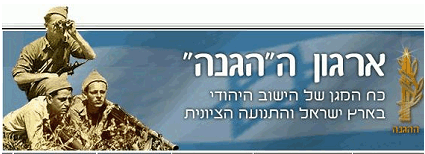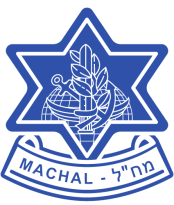by Smoky Simon

The Haganah was the largest underground military organization of the Yishuv in Eretz Yisrael from 1920-1948. The Arab riots in 1920 and 1921 strengthened the view that it was impossible to depend upon the British Authorities for the defense of the Yishuv, and that an independent defense force completely free of foreign authority had to be created, and in June 1920 the Haganah was founded.
The Arab riots in 1929 brought about a complete change in the Haganah’s status:
• It became a large organization encompassing nearly all the youth and adults in the settlements, as well as several thousand members from each of the cities.
• It initiated a comprehensive training program for its members, as well as officers’ training courses.
• It established a number of central arms deposits into which a continuous stream of light arms flowed from Europe.
• Simultaneously, the basis was laid for the underground production of arms.
During the period 1936-39, the years of the Arab Revolt, the Haganah matured and developed from a militia into a military body. Although the British Administration did not officially recognize the organization, the British Security Forces did co-operate with it by establishing a civilian militia (Jewish Settlement Police – J.S.P.), as well as the Jewish Auxiliary Police. In the summer of 1938, Special Night Squads (SNS) were established under the command of (British) Captain Orde Wingate, a great supporter of Zionism.
As a result of the British Government’s anti-Zionist policy as expressed in the White Paper of 1939, the Haganah supported illegal immigration and organized demonstrations against the British anti-Zionist policy.
With the outbreak of World War II, Jewish volunteers, men and women from the Yishuv, joined the British Army mostly in supportive units like Service, Transport, Engineering, etc. In 1944, the independent Jewish Brigade Group was formed and actually participated in actions in the last few months of the Italian campaign as part of the British Eighth Army. The Haganah also co-operated with British Intelligence Units and sent its personnel out on various commando missions in the Middle East, and Central Europe. An example of this co-operation was dropping 32 Jewish parachutists in 1943-44 behind enemy lines in the Balkans, Hungary, and Slovakia.
In 1941, the Haganah established the Palmach, an elite striking-force . At the end of the war, when it became clear that the British Government had no intention of altering its anti-Zionist policy, the Haganah began an open and organized struggle against British Mandatory Rule within the framework of a unified Jewish Resistance Movement, consisting of Haganah, Irgun Tzvai Leumi (Etzel), and Lochamei Herut Yisraeli (Lehi).
After World War II, Haganah branches were established at Jewish Displaced Persons (D.P.) camps in Europe, and Haganah members accompanied the “illegal” immigrant boats. In the spring of 1947, David Ben-Gurion directed the general policy of the Haganah, especially in preparation for the impending Arab attack. On May 26, 1948, the Provisional Government of Israel decided to transform the Haganah into the regular army of the State, to be called “Tzva Haganah L’Yisrael” (Zahal) – the Israel Defense Forces.
The Connection between the Haganah and Machal
In South Africa, many Machalniks were recruited through “The South African League for Haganah”, which was headed by two outstanding personalities, Simie Weinstein and Leo Kowarsky. Several thousand volunteered, including recruits from Kenya, Rhodesia and the Belgian Congo, but only a total of about 800 were accepted.
In America, a recruitment office called “Land and Labor for Palestine” was opened in New York, headed by Major Wellsley Aron, who had been an officer in the Jewish Brigade which served with the British Army in World War II. “Land and Labor for Palestine” was responsible for recruiting hundreds of American and Canadian volunteers with military expertise.
In February 1948, a separate agency was set up in the United States headed by Hyman Shechtman (Shamir) and assisted by Al Schwimmer, to recruit air force veterans, aircrew and ground crew for the Haganah’s ”Air Service.”
In Canada, recruitment began in early 1948, and within a very short time some 100 infantry and armored corps veterans of World War II enlisted in the service of the Haganah, and were sent to Haganah training camps in Europe before being transferred to Israel to fight in IDF units.
The “illegal” ships which brought new immigrants to Israel were accompanied by Hanagah members for security purposes. Many of these ships were outfitted and manned mainly by Machal volunteers from the USA and some from Canada.
In Western Europe, the Haganah delegation organized and supervised the recruitment of hundreds of volunteers in France, Britain, Switzerland Belgium and Holland. In Scandinavia, training camps were established in Sweden and Denmark. In the winter of 1948, 28 young Finns were enlisted.
In the War of Independence, the 8th Armoured Brigade was made up of “A” and “B” Companies. “B” Company, which was manned by Machalniks from South Africa, Canada, America, Latin America, France, and Czechoslovakia, was equipped with three tanks – two British Cromwells and one American Sherman, which had been acquired by the Haganah by bribing British soldiers at the time when the British Mandate over Palestine was coming to an end, and the British Forces were in the process of evacuation.
During the War of Independence many Machalniks served with ex-Haganah and ex-Palmach units which had been integrated into the Israel Defense Forces in May 1948.
Amongst the many female Machalniks who served in the Haganah was Esther Cailingold (of blessed memory) who came from England to teach English at a girl’s school in Jerusalem. When the war broke out, Esther enlisted in the Haganah and volunteered to join the forces defending the Jewish Quarter of the Old City, where she was killed in battle in the Spring of 1948. Zipporah (Zippy) Porath, an American student at the Hebrew University, enlisted in the Haganah and served as a medic during the siege of Jerusalem, and during the war she served in the Israel Air Force Medical Corps and IAF Intelligence.

